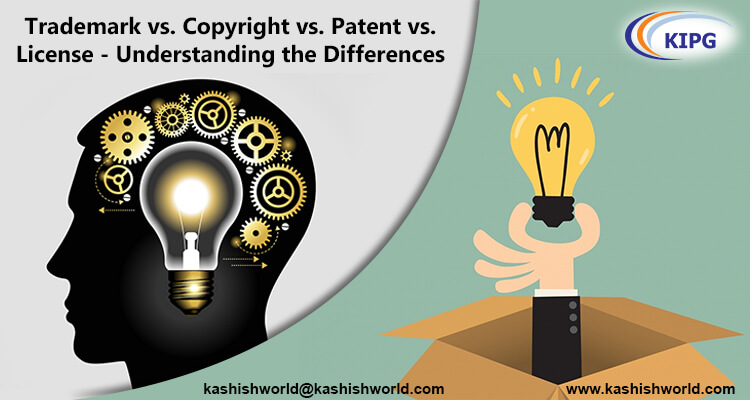
Intellectual Property (IP) is a vast and a bit complex term, which refers to the intangible creations of the human intellect. Artistic works, including writings and music, symbols, developed words, and phrases, scientific or non-scientific inventions and discoveries, all fall under the category of IP. In the present highly competitive business environment, Intellectual Property Laws exist to encourage the continued creation of a diverse range of innovations and inventions by offering Intellectual Property Protection against unauthorized use and theft. However, many people across the globe often get confused and incorrectly use the terms defined in IP law. They have even spoken of patenting a book and copyrighting an invention. For having a clear and concise knowledge of what IP entails, we need to understand the terms – patent, trademark, copyright, and license, which are all widely used in the context of IP. It is a matter of fact that yes – IP or the intellectual ideas are created in the human mind, but the term IP itself doesn’t refer to the ideas. The concept lies in how the idea materializes itself, and then we protect the end result with a trademark, patent, copyright, or license it. We may patent the design of a fuel-efficient car but not the idea behind the same. Similarly, the story of a book can seek Copyright Protection and not the idea of the book. Also, when you start a new company, you can obtain Trademark Protection for its logo and not for the idea of creating a logo.
WHAT IS A TRADEMARK?
Product and business owners usually go ahead with filing a Trademark Application. A trademark can be a slogan, word, symbol, logo, design, phrase, or color, which is capable of uniquely identifying and distinguishing a product or service from others in the industry. A trademark can represent the service or product itself, for example – iPhone X, a particular feature or element of the service or product, for example – FaceTime and AirDrop, or the brand name or provider of the service or product, for example – Apple. With Trademark Registration, the owner of the trademark gets public notice of ownership along with legal evidence of nationwide exclusive Trademark Rights. The trademark holder can also sue an infringer by initiating legal proceedings if the case calls for it. After getting the trademark registered, the owners can start using the ® symbol. A trademark can last forever provided the owners pay the due fees and file the necessary documents at the time of renewal; for instance – in India, trademark protection lasts for ten years, which is renewable every ten years on payment of the required fee.
WHAT IS A PATENT?
A patent is an exclusive form of IP granted to inventions. Patentable subject matter includes industrial processes, chemical compositions, machines, and manufactured artifacts and commodities. A patent usually belongs to the inventor that may be an organization or an individual. The patent owners may sell their invention or license it for enabling others to make use of their invention. For an invention to receive a patent grant, it has to meet certain conditions like it must be unique, novel, and useful. Hence, it is essential not to publicize your invention beforehand. A patent safeguards the invention from any other person or organization who may try to use, sell, distribute, modify, or license it without seeking the inventor’s permission. The patentee that is the owner of the patent can take legal action against anyone who uses the invention without his consent. For obtaining a patent, the aspirants have to File a Patent Application with the Intellectual Property Office, which shall decide whether the invention can receive a patent grant or not. In India, Patent Protection lasts for 20 years.
WHAT IS A COPYRIGHT?
Quite often, artists, authors, architects, choreographers, and other creative professionals seek copyright protection, which doesn’t extend to an idea but the tangible form of an idea. Copyrightable works include original and artistic creations, including photographs, music, poetry, songs, novels, paintings, movies, sculptures, and even business-related works and digital creations like website designs, software code, product manuals, marketing reports, and architectural drawings. The owner of a copyrighted work has the right to – reproduce, publish, display, or record the creative content or create derivative works in the form of revisions, translations, updates, adaptations, or summaries of the original work. By copyrighting creative and innovative IP, the copyright holders have a public notice and legal evidence of sole ownership. They can also sue a suspect in court against the issue of Copyright Infringement. In India, copyright protection usually lasts for 60 years. Artistic works are given copyright protection for a duration, which extends through the lifetime of the author and 60 years from the year in which he dies. In the case of photographs, computer programs, a copyright is granted for 60 years from the end of the year in which the work becomes available to the public once approved by the owner of the copyright.
LICENSING OF INTELLECTUAL PROPERTY
It refers to the legal contracts using which the owner of the IP (licensor) transfers his Intellectual Property Rights (IPRs) to an individual or any third party (licensee) who wishes to use them. It can be in the form of exclusive rights granted to only one licensee or non-exclusive rights granted to multiple licensees. Typically, a licensee pays the licensor a royalty for using his IP Rights. Royalties usually depend on how much revenue does the licensee generates from the sale of the products or services corresponding to the licensed IP Rights. Licenses hold immense potential for proving to be exceedingly valuable assets for any business. The licensor can generate a significant revenue stream through the royalty payments, and the licensee can drive the sales of his brand in the marketplace. Generally, licenses are drafted for a fixed period, say for example 5 years, which must be renewed on payment of minimum royalties, to extend the term.

